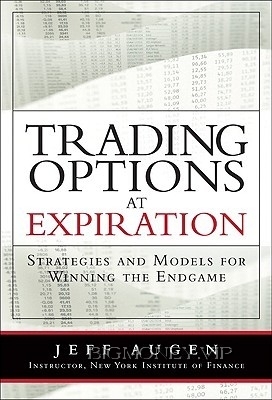Trading Options at Expiration: Strategies and Models for Winning the Endgame by Jeff Augen

Chapter 1
Expiration Pricing Dynamics
Equity and index options expire on the third Friday of each month.1
The
final hours of each expiration cycle are characterized by unusual market
forces and price distortions that, properly exploited, provide outstanding
trading opportunities. These distortions are caused by the breakdown of
traditional option pricing calculations that depend on volatility and time
decay to fairly represent risk. As a result, options are unavoidably mispriced
during the final few days.
End-of-cycle price distortions represent a market inefficiency that cannot
easily be exploited by large institutions for reasons related to liquidity and
execution efficiency. The trading strategies outlined in this book scale to
hundreds, but not thousands, of contracts. Institutions normally trade
thousands, tens of thousands, or even hundreds of thousands of contracts in
structured positions that must be capitalized through a lengthy pricing
process. These dynamics are best suited to private investors trading online
with accounts that range from $50,000 to no more than $10 million—an
order of magnitude smaller than most institutional accounts.
This approach to trading offers three compelling advantages: a reduced
risk/return profile, limited market exposure, and extremely high returns on a
percentage basis. In addition, the focus on price distortions and market
anomalies makes for a direction-neutral strategy that doesn’t rely on the
investor’s ability to “pick stocks.” We explore a variety of trades that
typically return anywhere from 40% at the conservative end to as much as
300% at the high end. In point of fact, just a few days before these words
were written—at the April 2008 expiration—the exchange-traded fund OIH
opened at $200 with the $200 straddle trading for approximately $2.50. By
12:00 the stock had climbed to $208, and the straddle was worth more than
$8.00—a 220% profit. Stated differently, every $10,000 invested grew to
$32,000. This sort of behavior is the norm on expiration day when stocks
move from one strike to another and options are very inexpensive. More
important, an investor who purchased this straddle risked only a modest
amount of steady time decay. A typical expiration Friday presents several
such opportunities.
In all cases, because we are actively trading these positions in real time with
no intention of taking any options home after the close, there is little risk of
losing money. Discipline is the key, and, as always, losing positions should
be closed or adjusted.
Market Forces
End-of-cycle effects that are not comprehended by contemporary pricing
models fall into three categories:
• Implied volatility collapse on the final trading day
• Strike price effects, including “pinning”
• Rapidly accelerating time decay
Implied Volatility Collapse
Collapsing volatility is a major driving force on expiration Friday. Early in
the day, stocks still have 6.5 hours of normal trading time left and more
than 38 hours before option contracts expire. Implied volatility is normally
consistent with recent historical volatility. However, at the market close,
more than one full day still remains before expiration. If implied volatility
remained relatively high, out-of-the-money options would have unrealistic
prices, and brokers would not purchase in-the-money options for Saturday
exercise. For example, when priced with 42% implied volatility, at-the-
money options on a $100 stock would still be worth more than $1.00 at the
close. This price would be unrealistic for options that can no longer be
traded by public customers. A trader, institutional or public, who purchased
these options for Saturday exercise would be gambling that the stock would
trade in the after-hours session, and that it would move more than $1.00 in
the correct direction.
We can extend this reasoning to explain smooth and rapid implied volatility
collapse. Suppose, for example, that the $100 strike price options
mentioned previously were priced with their characteristic 42% implied
volatility at 15:00 with one hour remaining before the final close. An
investor who purchased these contracts would be betting on a $1.00 move
Trading Options at Expiration: Strategies and Models for Winning the Endgame by Jeff Augen




